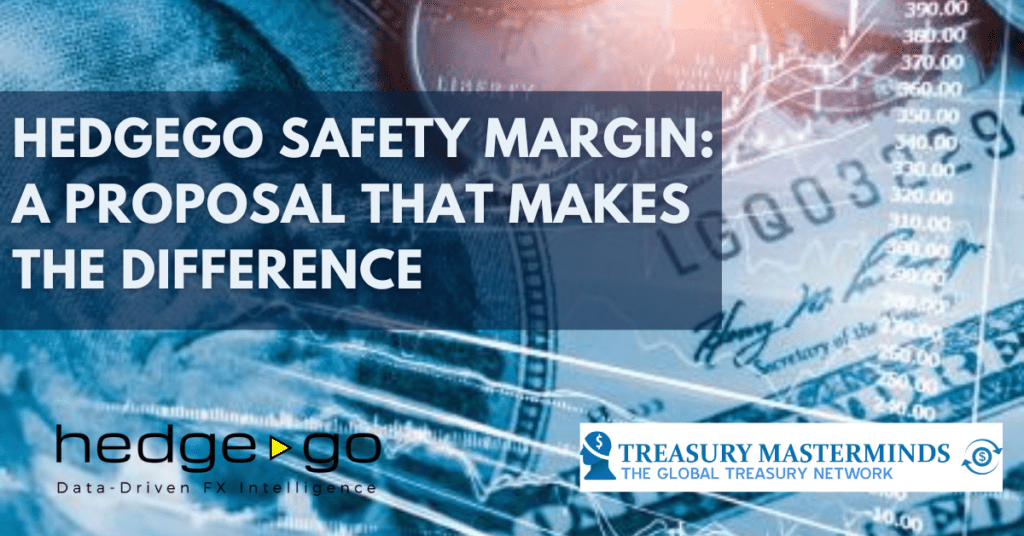
HedgeGo Safety Margin – A proposal that makes the difference
This article is written by HedgeGo What’s going on and what will go on Let’s come to the point quickly. Times are going to change and it will not stay for a short hello. There is a sustainable shift in fundamentals that will have a big impact on the markets in general and the FX markets in particular. If we first look at the inflation, trends are already manifesting evidently. This is not just a regional phenomenon, as inflation rates go up sharply in all major countries and currency zones, additional inflation is fired up by increasing price expectations. Nothing “massive” has happened yet, but you already can see that long-term loans are getting more expensive. Even more important for the FX market is, that higher volatility of interest rates will cause higher costs of securing it. How to address the situation Still, there are companies that believe that long term opportunities will outweigh hard hits in certain years. There is bad news for them. It is time to reconsider strategy, as actively managing FX risk can become a real game changer in international treasury. So, what can be done to take on the volatile nature of the future? Industry had an alternative to a “non-hedging” approach, the well-known 80%-hedging standard. For most of the companies using this way to hedge exposures, it became a part of Treasury DNA. However, still relying on rigid structures might become a problem in the coming years. What we need is a flexible way of dealing with threats, building safety margins with occurring opportunities while being financially well-equipped for hard hits. Introducing the idea of safety margins Treasury in international environments is all about managing risks but also using trend-supported opportunities. That’s why we came up with our “HedgeGo Safety Margin” system. 22 years of intensive consulting to international companies made us realize, that opportunities must be used to build up reserves for bad times. If you dig as deep as we do, trends become more reliable factors to improve financial results. Our internal consulting files showed a clear superiority of our “HedgeGo Safety Margin” approach over non-hedging or 80-hedging approaches. Ask for our fact sheets here. How does the HedgeGo Safety Margin work We defined the HedgeGo Safety Margin as: The yearly surplus (in %) gained for your financial result by using HedgeGo compared to ordinary hedging or “no-hedging” approaches. Being experts for the FX market for over 20 years, we established a data set up that allows us to dig deeper and understand sooner which trends are going to be established. We aim to deliver suggestions for an improved financial result by beating non-hedging or 80%-hedging performances. Including the first weeks 0f 2022, we succeeded in doing so, making our clients enjoy a 7% safety margin p.a. to comparable hedging strategies. How does the HedgeGo Safety Margin work in practice? Our internal system creates 4-6 order suggestions per year for one currency pair. For costs, that means good news, as we don’t follow daily technical approaches rather than building an understanding for trends. Also Read Join our Treasury Community Treasury Masterminds is a community of professionals working in treasury management or those interested in learning more about various topics related to treasury management, including cash management, foreign exchange management, and payments. To register and connect with Treasury professionals, click [HERE] or fill out the form below to get more information. Notice: JavaScript is required for this content.
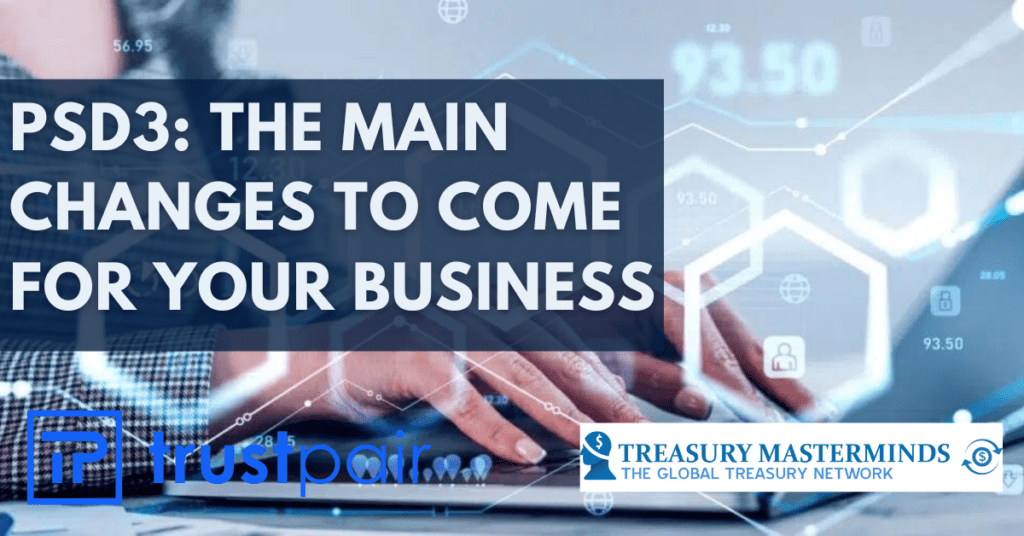
PSD3: The main changes to come for your business
This article is written by Trustpair The first Payment Services Directives (PSD and PSD2) have impacted our businesses. We have to go through stronger security measures to complete online payment transactions. While it has been successful in reducing fraud, the European Commission is now working on PSD3 to bring forth more regulations. Keep reading to learn the details! Do you have any questions, need any guidelines, or require any help in Treasury management? Treasurymasterminds is an online community of Treasurers who can provide you with the assistance you need in anything Treasury management. You can start a discussion on the forum to get the help you need. Don’t know how to start a discussion? Learn how to start a discussion on the forum. What is PSD3? PSD3 stands for Payment Service Directive — the third version of it. It’s a set of rules and requirements for payment services in Europe regulating how banks, payment institutions, and third-party providers process payments and financial data. PSD is the regulation that supported the development of Open Banking services. Its goals are to: PSD3 is still in its early stages and the directive is being worked on by the European Commission. While organizations have to start preparing for it, PSD2 is still the regulation to follow for now. Also Read PSD3 vs PSD2: what are the key differences? PSD2 and PSD3 share the same goals of creating more secure standards online for money services to: In the same way that PSD2 offered an improvement over the original PSD rules and requirements, PSD3 will be the natural evolution of PSD2. It’s not that PSD2 hasn’t been successful: regulatory institutions have declared it has enhanced security, fostered innovation, and helped develop Open Banking. But there is always room for improvement, which is why the European Commission is currently working on PSD3. The main goal of PSD3 is to harmonize even further the payment market across the EU and the EAA, reducing the space for national variation. To achieve this, the original PSD2 regulation will be split into two distinct elements: The creation of PSR means the scope of PSD3 will be far greater than the second iteration of the Payment Service Directive. The European Commission believes this will help stay up to date with the financial and payment landscape. PSD3: how will it impact payments? As the first and second versions of the Payment Service Directive did, PSD3 is forecasted to give a little shake to the payment industry — in Europe, but also to organizations worldwide that do business with European entities. While all the regulatory requirements haven’t been finalized yet, one thing is sure: PSD3 will impact the financial market (banks PSPs and fintech companies) and its consumers on the operational and legal sides. Organizations will need to create (or upgrade) new systems to comply with the new rules. Here are some of the expected requirements of PSD3: PSD3: what is the calendar? The third PSD PSR texts are currently under review by the European Parliament and European Council. While we don’t yet know the exact timeline, we know that: The European Banking Authority (EBA) also recently published an opinion which identifies new types and patterns of payment fraud, with solution proposals. This will without a doubt inform the shaping of PSD3. The good news is: you don’t have to wait until then to make your payments more secure. Trustpair is an anti-fraud software that completely eradicates the risk of third-party fraud in your business. Our solution provides ongoing account validation, checking your suppliers’ data in real time. This way, you always know who you’re paying, regardless of where your suppliers are located in the world. According to our latest survey, 96% of US businesses were targeted by at least one fraud attempt in 2023. Using Trustpair means knowing you won’t fall victim to CEO fraud or vendor fraud. Plus, we help you stay compliant with international regulations — and when the time comes, that will include PSD3 too! PSD3 is the new iteration of the Payment Services Directive PSD in the EU. It will replace PSD2 around 2026, aiming to increase customer protection, level playing field between banks and third party service providers, and foster innovation across Europe. Join our Treasury Community Treasury Masterminds is a community of professionals working in treasury management or those interested in learning more about various topics related to treasury management, including cash management, foreign exchange management, and payments. To register and connect with Treasury professionals, click [HERE] or fill out the form below to get more information. Notice: JavaScript is required for this content.
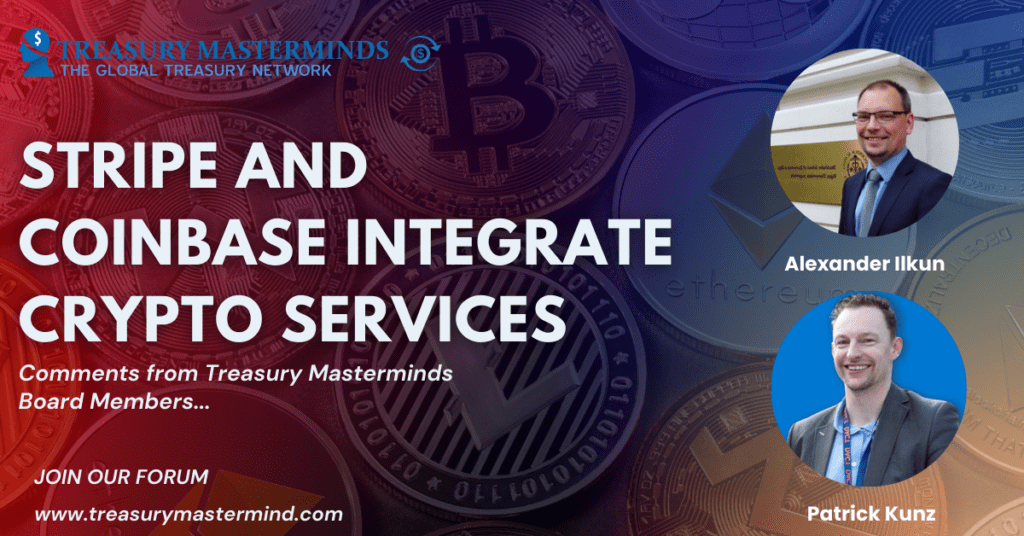
Stripe and Coinbase Integrate Crypto Services
Coinbase and Stripe have recently announced a partnership to promote the global adoption of cryptocurrencies. This collaboration aims to enhance the financial infrastructure by making crypto transactions faster and more affordable. Read more about the partnership in Coinbase + Stripe team up to expand global adoption of crypto Key Points of the Partnership: 1. Integration of Technologies 2. Global Reach and Accessibility 3. Benefits to Users and Businesses 4. Market Impact 5. Background Insights from Treasury Experts We thought it would be valuable to get perspectives from Treasury professionals, Alex Ilkun and Patrick Kunz, who are also Treasury masterminds board member Q: Do you see the partnership between Coinbase and Stripe to facilitate the increased demand for crypto payment in Corporate Treasury? If consumers are using crypto payments more should companies look to adopt it more? Alex Ilkun provided several insightful comments regarding the recent partnership between Coinbase and Stripe, focusing on the global adoption of cryptocurrencies. His views are captured below: 1. Benefits to Users and Businesses:I don’t quite see the speed of payments to typically be an issue in the corporate world, save for, possibly, M&A transactions, but it would be quite a niche and an infrequent use case for most companies. What could be a use case for corporates is the ability to make payments without being subject to cut-off times. However, it would require a significant penetration for that to happen since the parties will need to send and receive the funds, and I have doubts that penetration will occur. 2. Background and Concerns:My biggest concern about cryptocurrency usage by corporates is their seemingly widespread malicious use. Due to the anonymity it offers, cryptocurrency is enabling black market participation and sanction circumvention. The ease with which significant amounts can be transferred is not comparable with the logistics associated with suitcases of cash. As a corporate, it is a reputational matter to be involved in this structure. Blockchain technology boasts the ability to trace all the history of transactions, allowing you to see each unit of cryptocurrency travel between wallets. It’s easy to imagine a situation where a wallet is exposed to be criminal, making all the currency units that traveled through it tainted. Could a corporate that used one of those currency units be exposed to claims of engaging in criminal activity regardless of how remote? I’d claim yes as it would make a great story that would go viral. Now imagine a criminal network on purpose engaging with reputable companies to establish their wallet numbers? That would make a perfect recipe for a new era of digital crime. 3. Final Argument Against Cryptocurrency Use:My final argument against the use of cryptocurrency is that the currency should be a REASONABLE store of value. There are cryptocurrencies that are pegged to fiat, but it automatically reduces the range of currencies that can be used. Corporate Treasury will not hold significant amounts of funds in crypto as their value will change significantly in reporting currency. Therefore, at worst fiat will need to be exchanged to crypto for each sizeable settlement which is hardly efficient.” Patrick Kunz, CEO and Founder of Pecunia BV Treasury and Finance, Comments I would like to see Crypto as a payment type, not looking at it from an investment class perspective, so the risk is like just another foreign currency. The crypto can be used to send payments around quickly but there are some issues: (1) The transactions costs are not always clear up front. For some crypto your transaction costs are a factor on time and speed of the transaction (2) The transaction speed is not known up front (3) At the receiving end the crypto still bears price risk (i.e. like it is a foreign currency). (4) The anonymity of the receiver wallet could make it difficult to make sure there is no fraud involved. This doesn’t mean corporates shouldn’t look into it. To convert all their payments to crypto payments just for speed or transaction costs doesn’t make sense; we just have good alternatives for it. However, on the acceptance side I think corporates should not ignore it. If their market/customers would like to buy your goods with crypto a company should consider it. Stripe does offer the (immediate) exchange into fiat currency so quickly eliminating the price risk of crypto. A slight issue may incur if you have to do refunds in the same currency and buy back the crypto, but in a way this is also the case with FX risk. With the help of the PSP the hurdle to accept crypto as a payment type has decreased, using crypto also for pay outs and payments is another hurdle to take. Conclusion Overall, this collaboration between Coinbase and Stripe is a strategic move to leverage their respective strengths and drive the mainstream adoption of cryptocurrencies, making digital finance more inclusive and efficient for users worldwide. Recommended Reading Join our Treasury Community Treasury Mastermind is a community of professionals working in treasury management or those interested in learning more about various topics related to treasury management, including cash management, foreign exchange manage Notice: JavaScript is required for this content.

The Do’s and Don’ts of Payment Runs
This article is written by HedgeFlows Managing accounts payable is a critical component of financial operations for businesses. Efficiently handling numerous invoices and payments can be a daunting task, but with the right process it becomes streamlined and automated. This article delves into the world of payment runs, shedding light on its benefits, best practices, and potential pitfalls to avoid. Five Practices for Optimal Payment Runs Five Payment Runs Mistakes to Avoid After a Payment Runs is Made Following a payment run, there is typically a reconciliation step where payments are recorded in the accounting system and reconciled against the bills that have been settled. Modern accounting systems and payment automation software can automatically reconcile payments and invoices. It is common practice to send remittance notes or emails to notify a recipient when their payment is being processed. This provides details regarding the bills or other payables that the payment encompasses. This practice is optional but fosters stronger relationships with suppliers and mitigates the risk of miscommunication down the line. Also Read Join our Treasury Community Treasury Masterminds is a community of professionals working in treasury management or those interested in learning more about various topics related to treasury management, including cash management, foreign exchange management, and payments. To register and connect with Treasury professionals, click [HERE] or fill out the form below to get more information. Notice: JavaScript is required for this content.
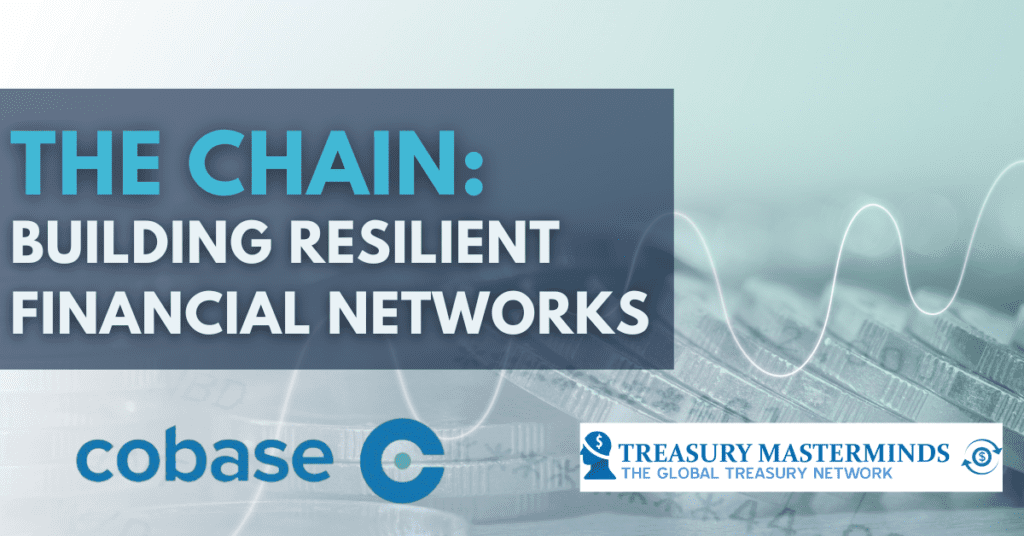
The Chain: Building resilient financial networks
This article is written by Cobase Fleetwood Mac’s “The Chain” is a powerful anthem about strength and connection, qualities that are just as essential in the world of financial operations. In this blog post, we’ll use the song as a metaphor to explore the importance of interconnected financial systems and the robust, reliable links needed to construct a well-integrated financial infrastructure. We’ll discuss how to ensure seamless connectivity and resilience, enabling your business to withstand economic fluctuations and thrive in a competitive landscape. The foundation of interconnected financial systems Interconnected financial systems form the backbone of any successful business. Like the links of a chain, each part of the financial system must work together seamlessly to support overall business functions—from accounting and procurement to sales and customer service. A well-integrated system ensures that information flows freely between departments, fostering better decision-making and improving efficiency. According to a report by Deloitte, companies with integrated financial systems see a 20% improvement in decision-making speed and accuracy due to enhanced data flow between departments. Strategies for building a resilient financial network Emphasizing connectivity and resilience Connectivity and resilience are key to maintaining a strong financial network. Just as “The Chain” emphasizes the unbreakable bond among its members, your financial network should be designed to withstand pressures both from within and outside the organization. Regular reviews and updates of your systems and processes can help maintain this strength over time. Regular system reviews and updates are essential, as reported by PwC, which notes that ongoing system maintenance can reduce system failure risks by up to 40%. Conclusion: the unbreakable link By viewing your financial operations through the lens of Fleetwood Mac’s “The Chain,” you can appreciate the critical role of connectivity and resilience in achieving business success. Building and maintaining a resilient financial network requires commitment to integration, standardization, and collaboration. With these elements firmly in place, your financial operations can act as a powerful, unbreakable chain driving your business forward. Also Read Join our Treasury Community Treasury Masterminds is a community of professionals working in treasury management or those interested in learning more about various topics related to treasury management, including cash management, foreign exchange management, and payments. To register and connect with Treasury professionals, click [HERE] or fill out the form below to get more information. Notice: JavaScript is required for this content.
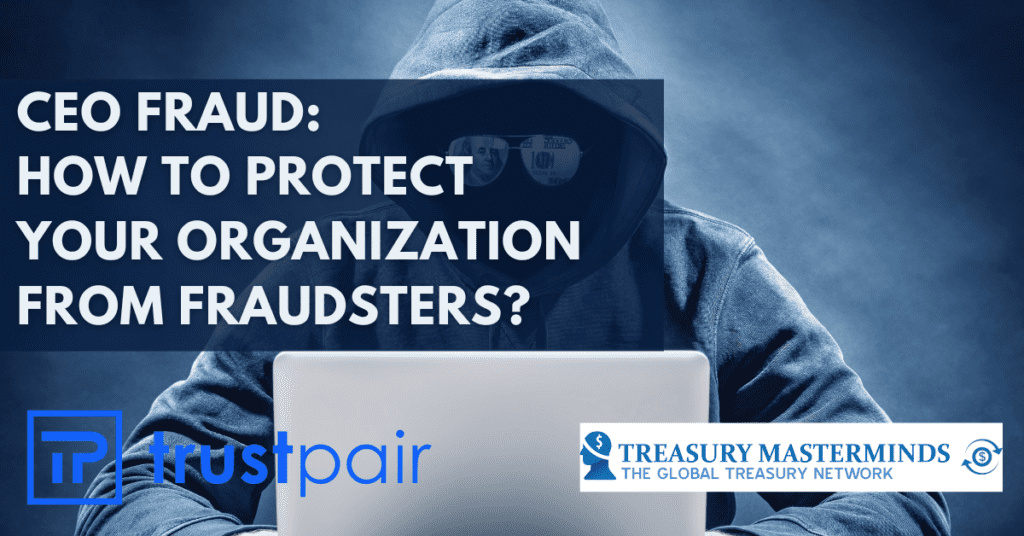
CEO fraud: How to Protect your Organization from Fraudsters?
This article is written by Trustpair CEO fraud is otherwise known as impersonation fraud, performed by highly organized criminals in targeted cybercrime attacks. Businesses often feel helpless regarding CEO fraud, since it’s not just about the hackers but also about the actions of their employees. But there are ways to prevent it, and in this article, you’ll learn how to protect your business from it. Read on for details! What is CEO Fraud? CEO Fraud is a type of impersonation or identity theft that can defraud companies out of thousands. Criminals send out emails to an unsuspecting employee pretending to be the CEO or another senior executive and ask them to deposit funds into a business account… except it’s not a business account. Instead, it’s an entirely separate account belonging to the criminals themselves, enabling them to steal huge amounts from organizations. Sometimes the fraudsters send a fake invoice and request an urgent payment for a “secret” partner or vendor. By placing high-pressure and time-sensitive conditions on their email requests, scammers can avoid scrutiny. It’s an effective tactic and executive fraud events (another name for CEO fraud) often appear in the news. In fact, in 2021, more than $2.4million was lost by businesses to CEO fraudsters. Impacts of CEO fraud There are three major impacts of CEO fraud scams on b2b organizations: In financial terms, CEO fraud has been known to cause millions of dollars of loss. For example, European company Leoni AG lost €40 million to a CEO fraud attack in 2016. The money was never recovered. In a regulatory sense, there are legislations all around the world that firms must adhere to, which help prevent CEO impersonation fraud. For example, here in the US, we follow SOX Law to increase levels of transparency and be able to trace accountability for certain decisions. SOX Law also helps prevent money laundering. Without detective controls (such as a traceable paper trail) that the regulations require, a case of CEO fraud would expose your company for not following the regulatory requirements. Non-compliance is another serious problem, leading to fines or imprisonment for senior executives. Finally, the reputational impacts of fraud (CEO scams in particular) could do the most damage to the business. When confidential company security systems are breached you have a duty to inform your customers (and sometimes, the authorities). This can generate mistrust of your brand among consumers, also causing stocks to tumble. In the case of Leoni AG mentioned above, the stock value dropped by 5-7% overnight. How does CEO fraud happen? CEO fraud attacks usually happen through a technique called spoofing. This impersonation technique allows the criminal to bypass cybersecurity and imitate the business email address of a senior manager or CEO. The employee will be asked either for a cash transfer from the company accounts or to share confidential information. Most often, mobile email users fall for this as the default email address doesn’t show in full on a mobile screen. Plus, the scammers use urgency techniques to rush the employees into making a decision without rational thinking. Finally, those without security awareness training are also likely to fall victim to a spear phishing attack from cybercriminals. In the past years, these attacks have become more and more sophisticated and linked to cyber fraud. On top of that, cybercriminals use social engineering techniques that make the attacks more credible and difficult to detect, even for a trained and cyber-aware employee. What’s the difference between CEO fraud and phishing? It’s important to note that CEO fraud is a separate ploy from phishing, even though there are some similarities CEO fraud is a much more targeted attack since the scammers already have insider information about the company’s background and how it is run. This is how they are able to spoof the CEO so convincingly. Instead, phishing scams are less targeted. Criminals will pretend to be a third-party company that deals with the business (think suppliers or delivery companies). Then, they send out the same email to thousands of employees from different organizations, hoping that one or two recognize the supplier and think the email is legitimate. However, both are types of Business Email Compromise (or BEC). What to do if you suspect you’ve fallen victim to impersonation fraud? First things first, contact your CEO or the person who you thought instructed you to carry out the payment or share information. Double-check their credentials and verify the information with your exec. Then, once it’s confirmed that you’ve fallen victim to a CEO fraud scam, notify your bank immediately. Provide evidence like the fraudulent email so that they can begin investigating immediately. Notifying the police to report the crime is also wise. Being reactive about it is the only chance you’ll have of getting your money back – even if it doesn’t guarantee it. If other confidential information is shared, be sure to change passwords immediately and perform an audit of your security. Now, it’s about risk management. Try to update your antivirus software to protect your email security against malware, too. What to do to prevent CEO fraud efficiently? Email fraud is not a new scam, but the way that criminals do it is constantly evolving. This is supposed to catch even the most suspicious of employees. But there are some things that you can do to help prevent CEO fraud in your organization. These include: Fraud Protection One of the best fraud protection methods is by using fraud prevention software like Trustpair. It automatically verifies banking information with the card number and account name and tracks historical finances to notify your business about anomalies and suspicious behavior. Any employee trying to wire money to an unknown account will be flagged and the transfer will be blocked. Moreover, installing a good antivirus program within the email system can help filter whaling scam attempts and junk more efficiently than the standard email software. Building a company culture that doesn’t involve high-pressure decision-making would also make an employee stop and question a time-sensitive rogue email. This means ensuring the payment approval process goes through several verification steps and empowering even junior staff to think for themselves. You…